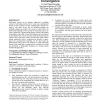Free Online Productivity Tools
i2Speak
i2Symbol
i2OCR
iTex2Img
iWeb2Print
iWeb2Shot
i2Type
iPdf2Split
iPdf2Merge
i2Bopomofo
i2Arabic
i2Style
i2Image
i2PDF
iLatex2Rtf
Sci2ools
ATAL
2009
Springer
2009
Springer
A mathematical analysis of collective cognitive convergence
Multi-agent systems are an attractive approach to modeling systems of interacting entities, but in some cases mathematical models of these systems can offer complementary benefits. We report a case study of how the two modeling methods can profitably engage one another. The system we study [12] is an agent-based simulation of how groups of interacting entities can come to think alike. Though formal analysis of most of the models in that paper is intractable, a mean field analysis can be performed for the simplest case. On the one hand, while the formal analysis captures some of the basic features of that model, other features remain analytically elusive, reinforcing the benefits of agentbased over equation-based modeling. On the other hand, the mathematical analysis draws our attention to certain interesting features of the model that we might not have considered if we had not performed it. Responsible modeling of a domain should include both approaches. Categories and Subject Descrip...
Agent-based Simulation | Artificial Intelligence | ATAL 2009 | Formal Analysis | Mean Field Analysis |
| Added | 26 May 2010 |
| Updated | 26 May 2010 |
| Type | Conference |
| Year | 2009 |
| Where | ATAL |
| Authors | H. Van Dyke Parunak |
Comments (0)

